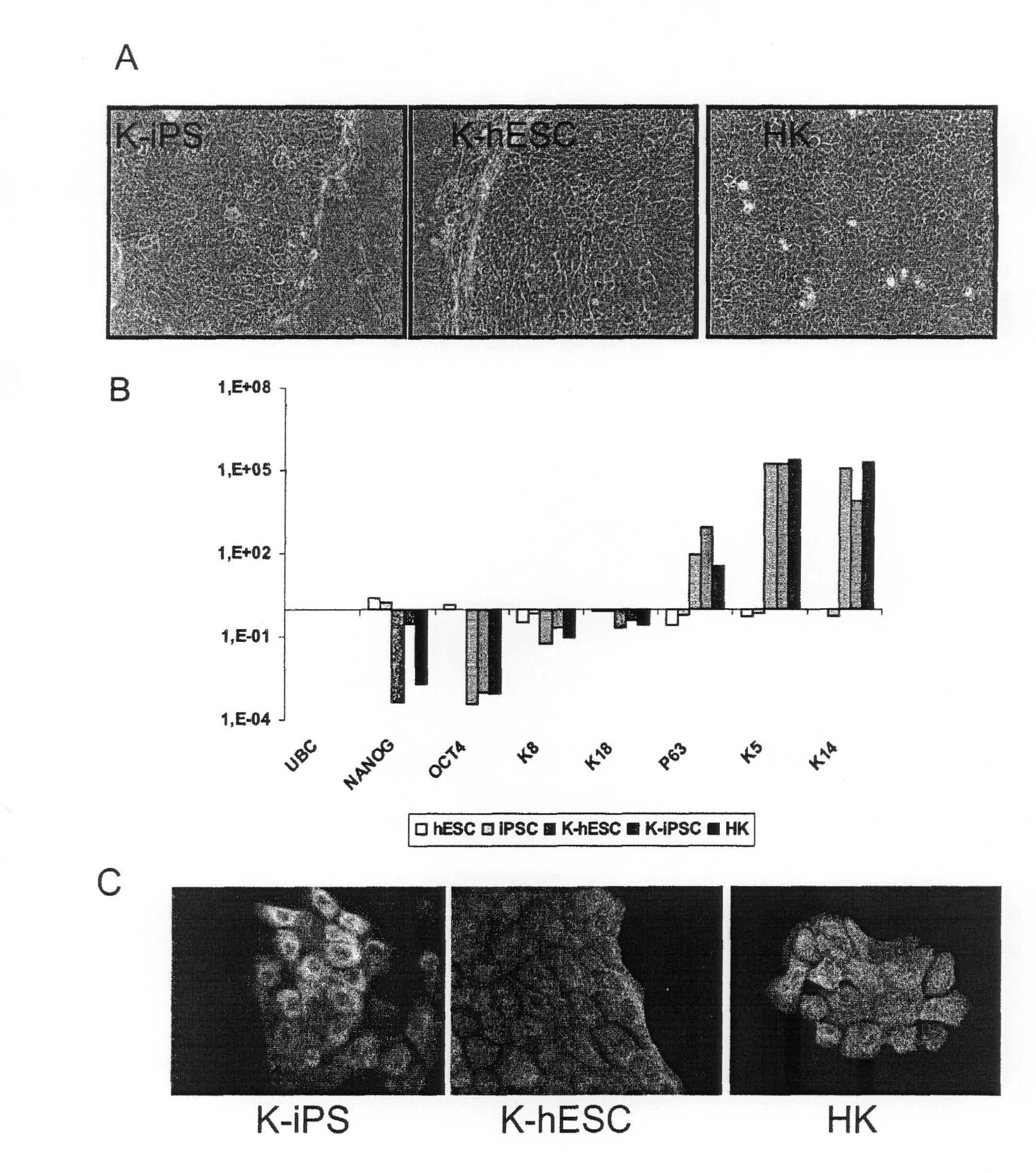Methods for preparing human skin substitutes from human pluripotent stem cells
A technology of human pluripotent stem cells and substitutes, applied in the field of preparation of human skin substitutes, which can solve the problems of not obtaining human keratinocytes
- Summary
- Abstract
- Description
- Claims
- Application Information
AI Technical Summary
Problems solved by technology
Method used
Image
Examples
Embodiment 1
[0112] Example 1: Method for Preparation of Keratinocyte Populations and Human Skin Substitutes from hES
[0113] Materials and methods
[0114] Maintenance of hES cells
[0115] hESC (SA-01 and H9) at 37°C, 5% CO 2 Grow on a feeder layer of mouse fibroblasts supplemented with 20% (v / v) Knockout Serum Replacement (KSR, Invitrogen), 1 mM glutamine, 0.1 mM non-essential amino acids (Invitrogen), 4ng / ml recombinant human bFGF (PeProTech) and STO in DMEM / F12 (Sigma) of 0.1mM 2-mercaptoethanol (inactivated with 10mg / ml mitomycin C and treated at 30000 / cm 2 vaccination). For passaging, hESC colonies were dissected and passaged every 5 days.
[0116] Derivation of hES cells from keratinocytes.
[0117] For derivation, colonies were plated on mitomycin C-treated 3T3 fibroblasts in FAD medium consisting of 2 / 3DMEM, 1 / 3 HAM:F12 and 10% fetal calf serum (FCII , Hyclone), supplemented with 5μg / ml insulin, 0.5μg / ml hydrocortisone, 10 -10 M cholera toxin, 1.37 ng / ml T3, 24 μg / ml aden...
Embodiment 2
[0147] Example 2: Method for Preparation of Keratinocyte Populations and Human Skin Substitutes from iPS
[0148] The same differentiation protocol as described in Example 1 was performed with human induced pluripotent stem (iPS) cells. Briefly, iPS were seeded on mitomycin C-treated 3T3 fibroblasts in FAD medium consisting of 2 / 3 DMEM, 1 / 3 HAM:F12, and 10% fetal calf Serum (FCII, Hyclone) composition supplemented with 5 μg / ml insulin, 0.5 μg / ml hydrocortisone, 10 -10 M cholera toxin, 1.37 ng / ml triiodothyronine, 24 μg / ml adenine and 10 ng / ml recombinant human EGF. Induction of ectodermal differentiation was performed when 0.5 nM human recombinant BMP-4 (R&D Systems Europe, UK) and 0.3 mM ascorbic acid (Sigma) were added. Cells were grown in the same medium until colonies of epithelial cells were isolated. Cells were then plated on the same feeder layer in FAD medium without BMP4 and ascorbic acid. As a control, primary human keratinocytes (HK) were cultured on mitomycin C...
PUM
 Login to View More
Login to View More Abstract
Description
Claims
Application Information
 Login to View More
Login to View More - R&D
- Intellectual Property
- Life Sciences
- Materials
- Tech Scout
- Unparalleled Data Quality
- Higher Quality Content
- 60% Fewer Hallucinations
Browse by: Latest US Patents, China's latest patents, Technical Efficacy Thesaurus, Application Domain, Technology Topic, Popular Technical Reports.
© 2025 PatSnap. All rights reserved.Legal|Privacy policy|Modern Slavery Act Transparency Statement|Sitemap|About US| Contact US: help@patsnap.com



